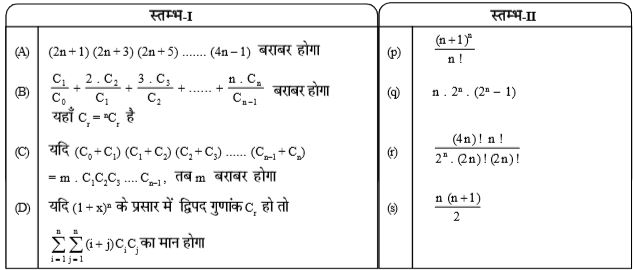कथन-I यदि q=13 तथा p+q=1 तब 15∑r=0r15Crq15−r=15×13=5 है
क्योकि
कथन-II यदि p+q=1, 0<p<1 तब n∑r=0rnCrprqn−r=np है
कथन I सत्य है, कथन II सत्य है कथन II, कथन-1 का सही स्पष्टीकरण है।
कथन I सत्य है, कथन सत्य है कथन II, कथन-1 का सही स्पष्टीकरण नहीं है।
कथन-I सत्य है परन्तु कथन-II असत्य है।
कथन -Iअसत्य है परन्तु कथन -II सत्य है।
The correct Answer is:D
Step by step video, text & image solution for कथन-I यदि q=1/3" तथा "p+q=1" तब "underset(r=0)overset(15)sum r^(15)C_(r) q^(15-r)=15 xx 1/3 =5 है क्योकि कथन-II यदि p+q=1, 0 lt p lt 1" तब "underset(r=0)overset(n)sum r ""^(n)C_(r) p^(r) q^(n-r)=np है by Maths experts to help you in doubts & scoring excellent marks in Class 11 exams.
Updated on:21/07/2023Topper's Solved these Questions
- द्विपद प्रमेयBook:ALLEN HINDIChapter:द्विपद प्रमेयExercise:Exercise -03
Explore 4 Videos
- द्विपद प्रमेयBook:ALLEN HINDIChapter:द्विपद प्रमेयExercise:Exercise -04 [A]
Explore 28 Videos
- द्विपद प्रमेयBook:ALLEN HINDIChapter:द्विपद प्रमेयExercise:Exercise -03 (स्तम्भ सुमेलन )
Explore 1 Video
- द्विघात समीकरण Book:ALLEN HINDIChapter:द्विघात समीकरण Exercise:EXERCISE-4 B
Explore 11 Videos
- बिन्द् एवं सरल रेखा Book:ALLEN HINDIChapter:बिन्द् एवं सरल रेखा Exercise:EXERCISE-04 [B] (BRAIN STORMING SUBJECTIVE EXERCISE)
Explore 14 Videos
Similar Questions
यदि n धनात्मक पूर्णांक तथा (1+4x+4x2)n=2n∑r=0arxr जहाँ ai,r,(i=0,1,2,3,...,2n) वास्तविक संख्याये है
2n∑r=0a2r का मान होगा-
View Solutionयदि (1+x)18 के विस्तार में (2r+4) वों पद तथा (r−2) वों पद के गुणांक समान हैं, तो r का मान है
View Solution
View Solutionयदि द्विघात समीकरण ax2+bx+c=0 का एक मूल दूसरे मूल का n वीं घात के बराबर है, तो दिखाइए की
(acn)1n+1+(anc)1n+1+b=0
View Solution(-2,-7) से गुजरने वाली तथा सरल रेखाओं 4x + 3y = 12 एवं 4x +3y=3 के मध्य 3 इकाई का अन्तः खण्ड काटने वाली रेखाओं की समीकरण ज्ञात कीजिए।
View SolutionIf p+q=1, then value of sum_(r=0)^(n)r^(2)C(n,r)p^(r)q^(n-r) is (1)npq(2)np(1+q) (3) n^(2)p^(2)+npq(4)np^(2)+npq
View SolutionIf p+q=1 then show that sum_(r=0)^(n)r^(2)C_(r)p^(r)q^(n-r)=npq+n^(2)p^(2)
View SolutionIf p+q=1, then show that n∑r=0r2^nCrprqn−r=npq+n2p2.
View SolutionIf nC0,nC1,...,nCn denote the binomial coefficients in the expansion of (1+x)nandp+q=1 , then n∑r=0r.nCrprqn−r=
View SolutionIf (n)C0,(n)C1,(n)C2,....,(n)Cn, denote the binomial coefficients in the expansion of (1+x)nandp+q=1 n∑r=0r2 nCrprqn−r= .
View Solutionn−1∑r=0.nCr.nCr+.nCr+1 equals
View Solutionn∑r=0(−1)r.nCr[12r+3r22r+7r23r+15r24r+...m terms]=
View SolutionLet n be a positive integer and
(1+x)n+C0+C1x+C2x2+C3x3+...+Crxr+...+Cn−1xn−1+Cnxn
Where Cr stands for .nCr, then
Q. The values of n∑r=0n∑s=0(Cr+CS) is
View SolutionLet n be a positive integer and
(1+x)n+C0+C1x+C2x2+C3x3+...+Crxr+...+Cn−1xn−1+Cnxn
Where Cr stands for .nCr, then
Q. The value of n∑r=0n∑s=0,Cr,CS is
View SolutionIf Sn=n∑r=01nCr and Tn=n∑r=0rnCr then tnsn =
View Solution
